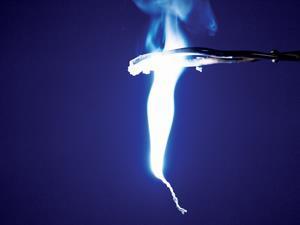Aim - To show that hydrogen gas is produced when a metal reacts with an acid.
Equipment - A test tube, a boiling tube, Bunsen Burner, Wooden splint, Hydrochloric acid, A piece of magnesium, Safety Glasses.
Method -
1. Light your bunsen burner.
2. Add your sample of metal to your test tube. Add 2mL of acid.
3. Carefully invert the boiling tube above the test tube containing the metal and acid.
4. Hold the test tubes together for a few minutes, allowing time for the inverted boiling tube to fill with gas.
5. when you think your tube is full, your lab partner should light a wooden splint.
6. Carefully, but quickly, tilt the boiling tube full of gas upwards and insert the burning splint into the mouth of the test tube.
Results -
When we added the hydrochloric acid to the magnesium the liquid turned a milky white colour and started bubbling, When putting the fire into the hydrogen gas that the reaction between the metal and acid had created, it made a high pitched pop that sounded halfway between a pop and a squeak.
Conclusion -
When fire mixes with hydrogen gas it immediately extinguishes and creates a high pitched popping sound as a result. This is because hydrogen reacts with oxygen in the air in a small explosion.
Metal Oxide Experiment -
Aim - To make a metal oxide and observe the difference in properties of the product compared to the reactants.
Equipment - A piece of magnesium, Bunsen burner, Saftey Glasses, Metal scissor Tongs.
Method -
1. Light your bunsen burner
2. Hold your piece of magnesium in the scissor tongs. Ensure you are holding onto the very tip of the magnesium.
3. Place the other end of the magnesium into the bunsen burner flame (at the top of the blue flame)
4. When the magnesium begins to burn, do not look directly at it, as the light admitted can permanently damage your eyes.
Results -
As the magnesium started to heat up it flopped down, then started reacting with the oxygen and the magnesium caught aflame. We then took the metal out of the flame and it created a bright white light and produced a stream of white smoke, When it cooled it had turned into an ashy texture with a light grey colour.
Conclusion -
Before the reaction occurred The magnesium was a thin strip with a shiny lustre and was malleable, As the reaction between the magnesium and oxygen took place it created a very bright white light and produced a grey, ash, powder-like substance.
(Magnesium + Oxygen --------> Magnesium Oxide)

Testing for the presence of oxygen -
Aim - To carry out a test for the presence of oxygen gas (O2)
Equipment - A peasized amount of manganese dioxide (MnO2), Boiling tube, Bottle of hydrogen peroxide (H2O2), Safety Glasses, Wooden splint, Bunsen burner, Test tube rack.
Method -
1. Light your bunsen burner
2. Add the manganese dioxide to the boiling tube and place it in your test tube rack.
3. Add 2mL of hydrogen peroxide.
4. Light a splint and let it burn for a while.
5. Blow the splint out and insert the glowing embers into the mouth of the boiling tube.
Results -
When we added the manganese dioxide and the hydrogen peroxide it started to rise and bubble and released an oxide, When we inserted the glowing embers of the splint into the oxide it lit right back up again. My group found that we could do this process 5-6 times before having to add more hydrogen peroxide.


Excellent detail across a range of experiments Lucy. I especially liked your interpretation of the results and how you explained the science behind them. I think your next steps will be to start designing your own experiments to discover new ideas in science you are curious about. Ka pai, keep up the fantastic work.
ReplyDelete